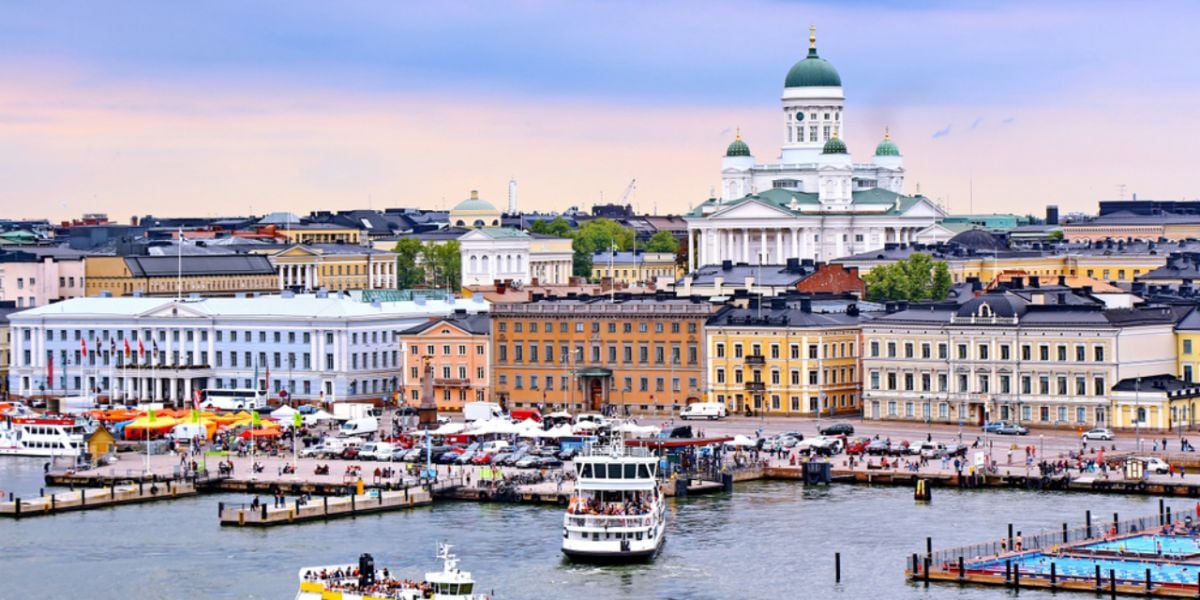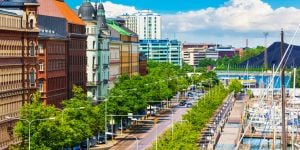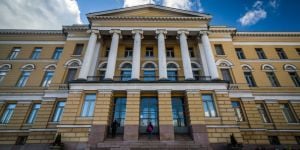
When approaching Helsinki on a plane, the announcement to fasten your seat belts may surprise you. Outside the window, you can see mostly forests, coastline and a pond here and there. Where is the city? Even if the Helsinki Metropolitan area has some 1.5 million inhabitants they are quite spread out leaving many green pockets between residential areas.
Touchdown in Helsinki
The airport itself, nowadays a hub between the rest of Europe and Asia is conveniently situated and just a 30-minute bus or train ride away from the Central Station.
Obviously, arriving by ferry, for example from Tallinn or Stockholm, is another kind of experience. You will be harbouring in the heart of the city welcomed by its neoclassical architecture and the impressive Dome of Helsinki.
The climate in Helsinki
Like many northern cities, Helsinki has two characters. Wintertime may demand some resilience and endurance. Between November and February, days are rather short and rain and sleet may hit you hard. But, the season has its definite charm as well. When there is snow the city is a winter sports haven – skiing and skating even on a frozen sea are major attractions.
Helsinki has also developed into a nice Christmas city with lights, decorations and markets. Persistent myths about polar bears wandering the streets are simply not true. The climate and the temperature are comparable to, let's say, Toronto. February is the coldest month, July warmest. The average temperature (entire year) is 5.9 Celsius.
In the summertime, Helsinki, founded in 1550 by the Swedish King Gustavus Vasa, is bathing in light. The contrast is huge. The city and its inhabitants open up. People enjoy the numerous parks and cafes, go sailing or jump on a bicycle. Many also head towards their summer cottages, so especially in midsummer and during the holiday peak of July the city can feel a bit quiet and empty.
The lifestyle in Helsinki
The first impression people might give is that they are a bit reserved and shy. Just give them a bit of time to warm up. Small talk may not be their strongest asset, but at heart, they are very helpful and ready to socialise – and not just on a superficial level. Practically everyone speaks English, which makes everyday life easy. Adding to the comfort factor is Helsinki's true reputation as one of the safest and cleanest cities in the world.
Getting around Helsinki
Helsinki has a transport system that is working well. Owning a car is not a necessity since buses, trams, metro, ferries and trains cover the whole area. And you can always use the city scooters and bikes from April till the end of October or use carpool services. Downtown Helsinki is rather compact, so walking is often the quickest way to get around. The city is situated in the peninsula, so the traffic can get jammed. If you live a bit further from downtown trains are recommendable for commuting.
The easiest and cheapest option to travel around the region is to get an HSL card. Single tickets are sold in machines and R-kiosks. You can also either buy a season ticket or pay for your journeys with value stored on your card or download and use an HSL app on your mobile phone. The area is divided into four zones and prices are based on the distance.
The cost of living in Helsinki
According to some reports, Finland has been ranked the eighth most expensive country in Europe and the 20th in the world. Alcohol, cigarettes and hotel stays are pricy, whereas the costs for electricity and communications services like internet access are reasonable, even cheap. When it comes to food and restaurants, the margins are wide. Thanks to immigrants, the city's culinary map is rich and varied. A very decent lunch costs around ten Euros.
Whether you are considering buying a house or flat or renting the amount of money you have to spend depends hugely on the area. The old working-class-district-turned-hipster-haven of Kallio is on another planet compared to the aristocratic and bourgeoisie corners of Eira.
In general, it is fair to say that accommodation in Helsinki is expensive. The city is growing fast, and even though there has been a construction boom, the supply and demand don't always meet. Obviously, downtown is for those who can afford it. In an expensive area, a flat of around 85 square metres can cost roughly 2,000 Euros a month. Choose a less posh neighbourhood, and the rent can be 50 per cent less.
Education in Helsinki
International schools in the Helsinki Metropolitan area are plenty. Tuition is offered in English, Russian, German, French, and Swedish. Some schools have International Baccalaureate (IB) and Cambridge programmes. The European School of Helsinki is situated right in downtown.
Helsinki is also the city of higher education and scientific research. The University of Helsinki with its 40,000 students and eleven faculties is ranked within the top 100 of the world's universities. Not to forget is Aalto University combining art, technology and business into something often extraordinary.
For now, the fees for Bachelor's and Master's Programmes in English have been between 13,000 and 18,000 EUR per academic year, depending on the programme. There are no fees for exchange students, PhD students and citizens of the European Union (EU), the European Economic Area (EEA) and Switzerland. The same applies to individuals with a permanent Finnish residence permit or long-term resident's EU residence permit in Finland.
Useful links:
We do our best to provide accurate and up to date information. However, if you have noticed any inaccuracies in this article, please let us know in the comments section below.








